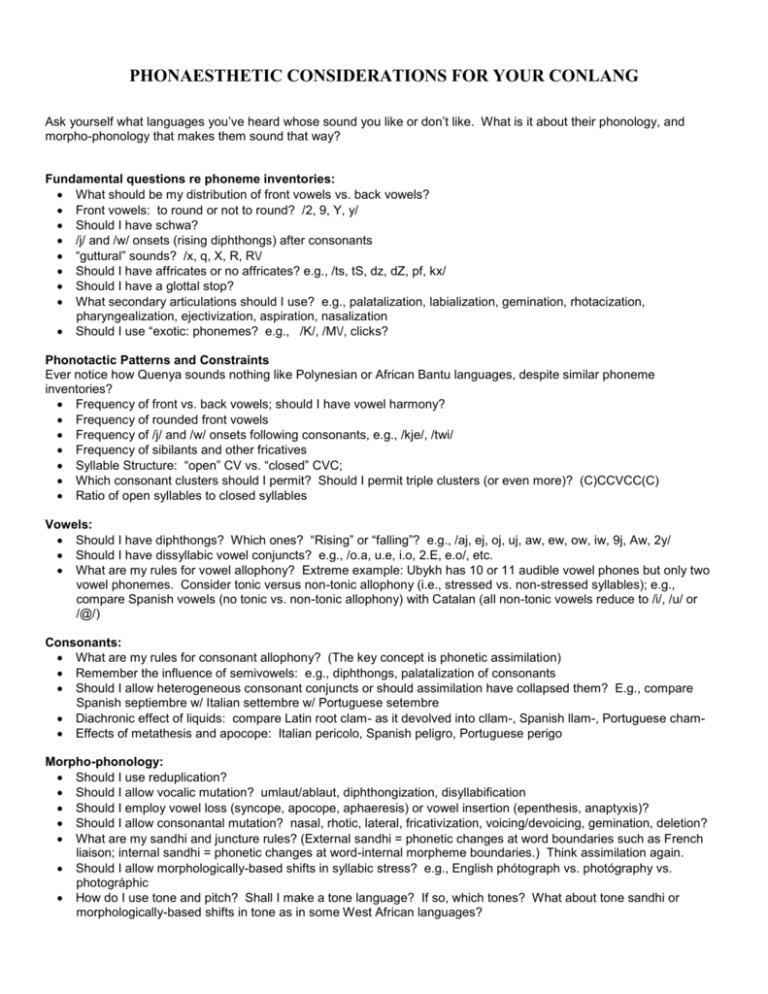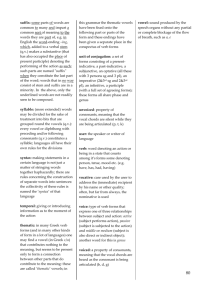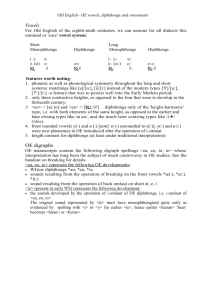Handout
advertisement

PHONAESTHETIC CONSIDERATIONS FOR YOUR CONLANG Ask yourself what languages you’ve heard whose sound you like or don’t like. What is it about their phonology, and morpho-phonology that makes them sound that way? Fundamental questions re phoneme inventories: What should be my distribution of front vowels vs. back vowels? Front vowels: to round or not to round? /2, 9, Y, y/ Should I have schwa? /j/ and /w/ onsets (rising diphthongs) after consonants “guttural” sounds? /x, q, X, R, R\/ Should I have affricates or no affricates? e.g., /ts, tS, dz, dZ, pf, kx/ Should I have a glottal stop? What secondary articulations should I use? e.g., palatalization, labialization, gemination, rhotacization, pharyngealization, ejectivization, aspiration, nasalization Should I use “exotic: phonemes? e.g., /K/, /M\/, clicks? Phonotactic Patterns and Constraints Ever notice how Quenya sounds nothing like Polynesian or African Bantu languages, despite similar phoneme inventories? Frequency of front vs. back vowels; should I have vowel harmony? Frequency of rounded front vowels Frequency of /j/ and /w/ onsets following consonants, e.g., /kje/, /twi/ Frequency of sibilants and other fricatives Syllable Structure: “open” CV vs. “closed” CVC; Which consonant clusters should I permit? Should I permit triple clusters (or even more)? (C)CCVCC(C) Ratio of open syllables to closed syllables Vowels: Should I have diphthongs? Which ones? “Rising” or “falling”? e.g., /aj, ej, oj, uj, aw, ew, ow, iw, 9j, Aw, 2y/ Should I have dissyllabic vowel conjuncts? e.g., /o.a, u.e, i.o, 2.E, e.o/, etc. What are my rules for vowel allophony? Extreme example: Ubykh has 10 or 11 audible vowel phones but only two vowel phonemes. Consider tonic versus non-tonic allophony (i.e., stressed vs. non-stressed syllables); e.g., compare Spanish vowels (no tonic vs. non-tonic allophony) with Catalan (all non-tonic vowels reduce to /i/, /u/ or /@/) Consonants: What are my rules for consonant allophony? (The key concept is phonetic assimilation) Remember the influence of semivowels: e.g., diphthongs, palatalization of consonants Should I allow heterogeneous consonant conjuncts or should assimilation have collapsed them? E.g., compare Spanish septiembre w/ Italian settembre w/ Portuguese setembre Diachronic effect of liquids: compare Latin root clam- as it devolved into cllam-, Spanish llam-, Portuguese cham Effects of metathesis and apocope: Italian pericolo, Spanish peligro, Portuguese perigo Morpho-phonology: Should I use reduplication? Should I allow vocalic mutation? umlaut/ablaut, diphthongization, disyllabification Should I employ vowel loss (syncope, apocope, aphaeresis) or vowel insertion (epenthesis, anaptyxis)? Should I allow consonantal mutation? nasal, rhotic, lateral, fricativization, voicing/devoicing, gemination, deletion? What are my sandhi and juncture rules? (External sandhi = phonetic changes at word boundaries such as French liaison; internal sandhi = phonetic changes at word-internal morpheme boundaries.) Think assimilation again. Should I allow morphologically-based shifts in syllabic stress? e.g., English phótograph vs. photógraphy vs. photográphic How do I use tone and pitch? Shall I make a tone language? If so, which tones? What about tone sandhi or morphologically-based shifts in tone as in some West African languages?








